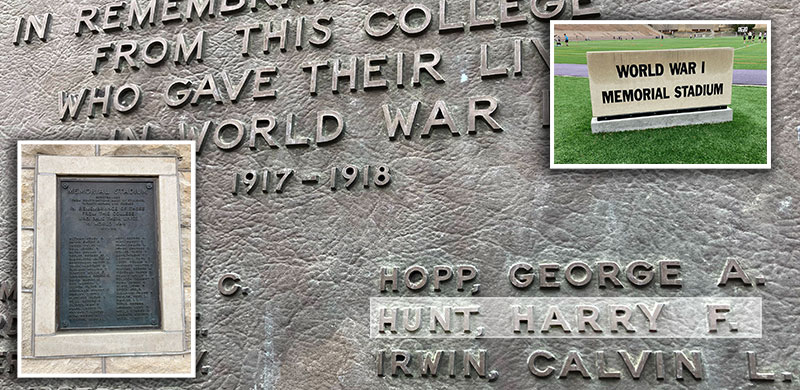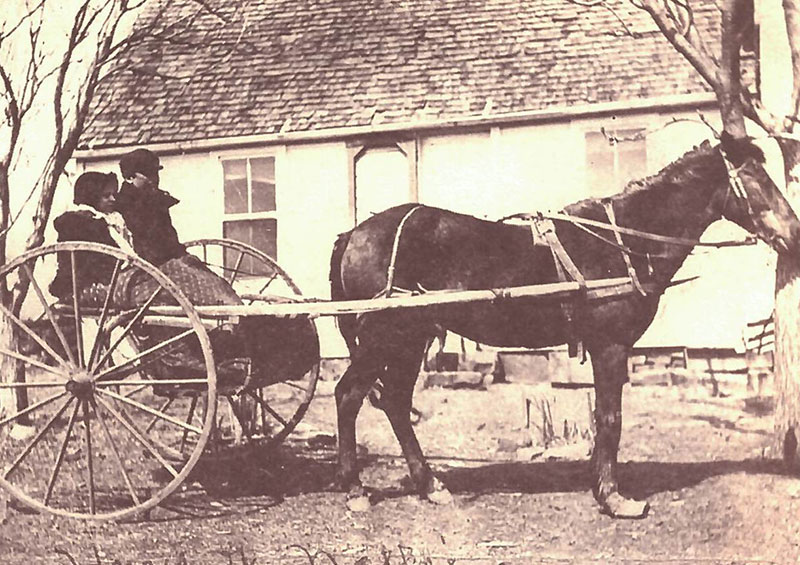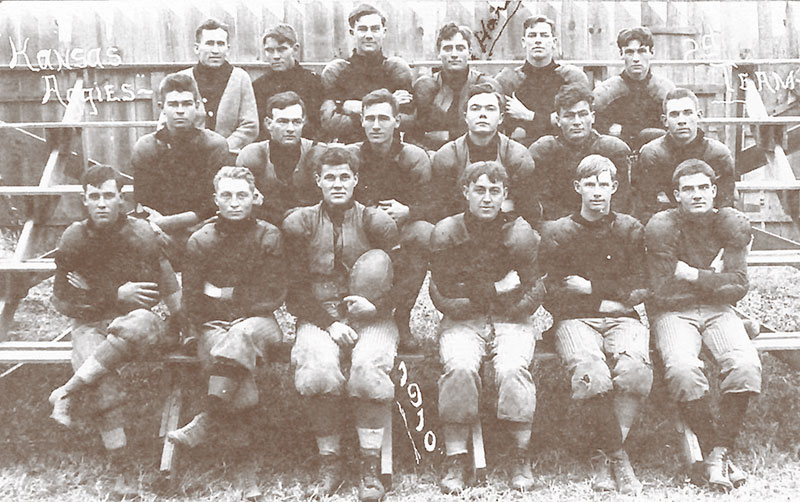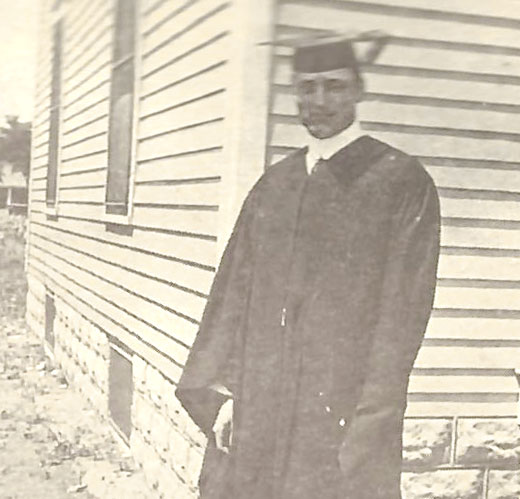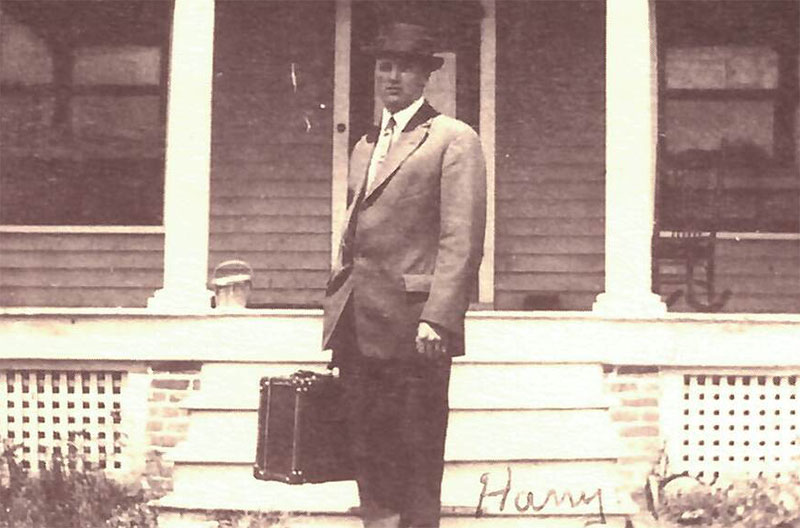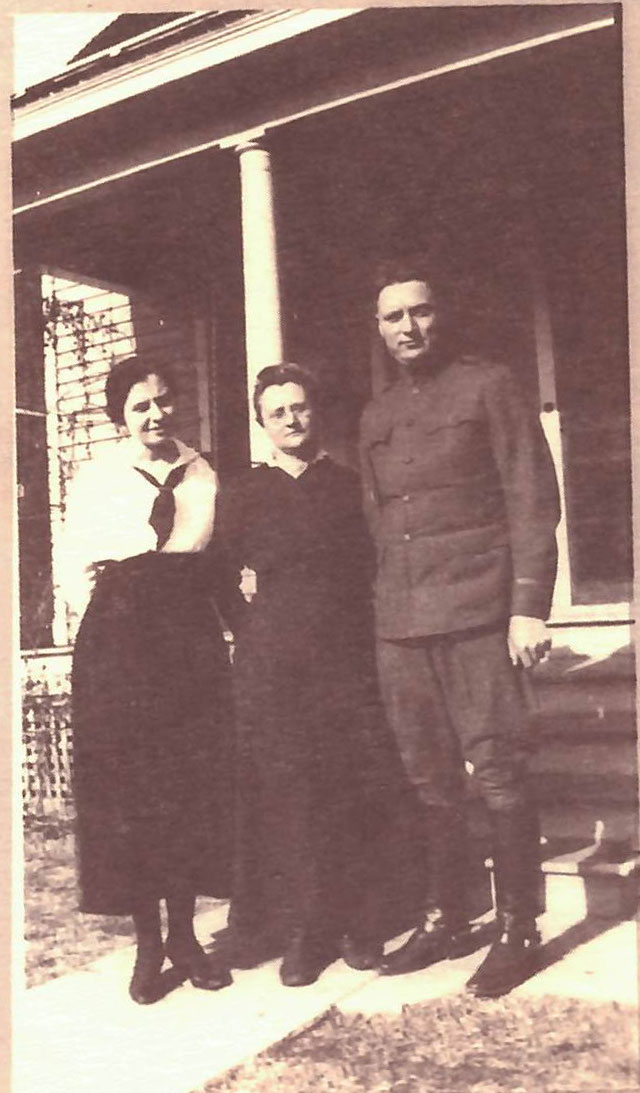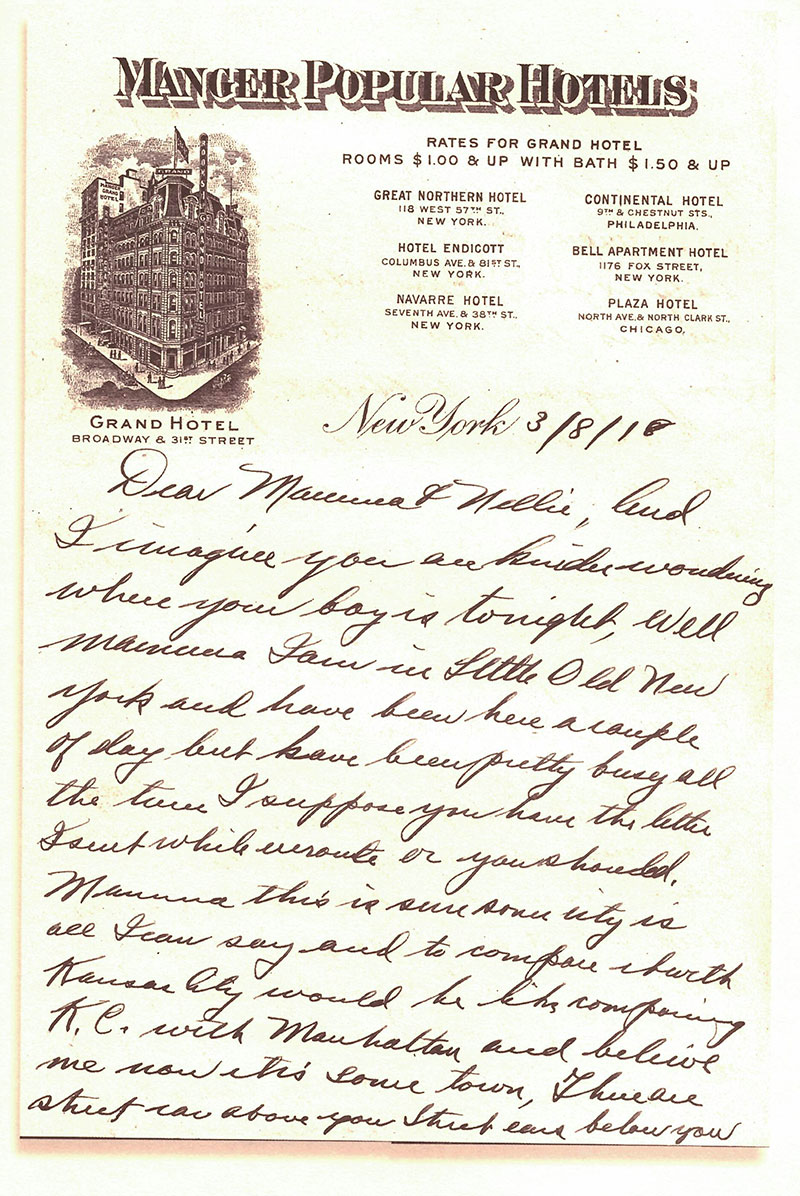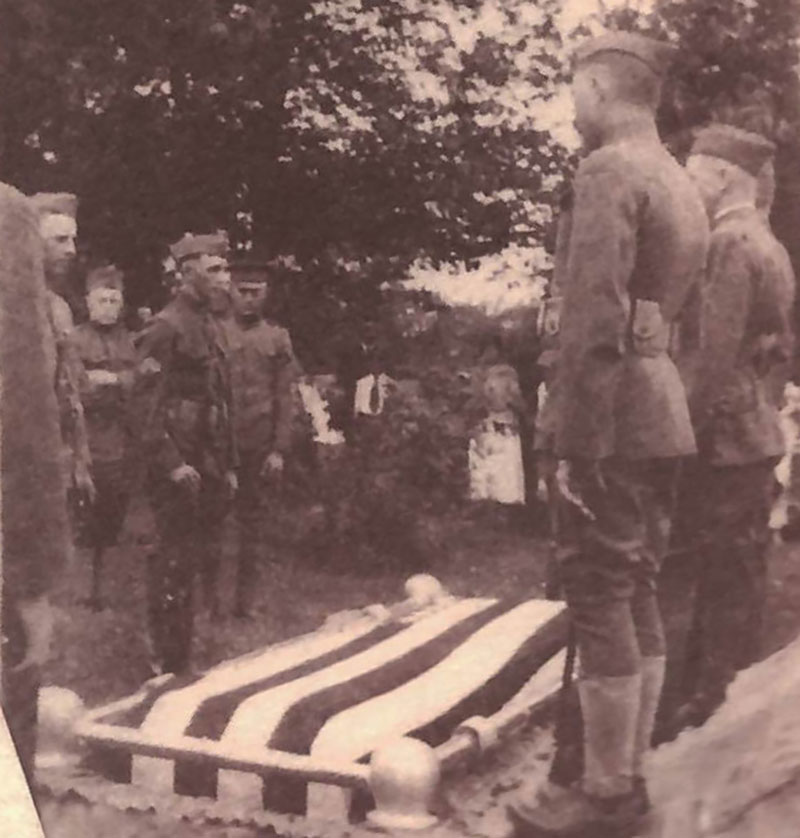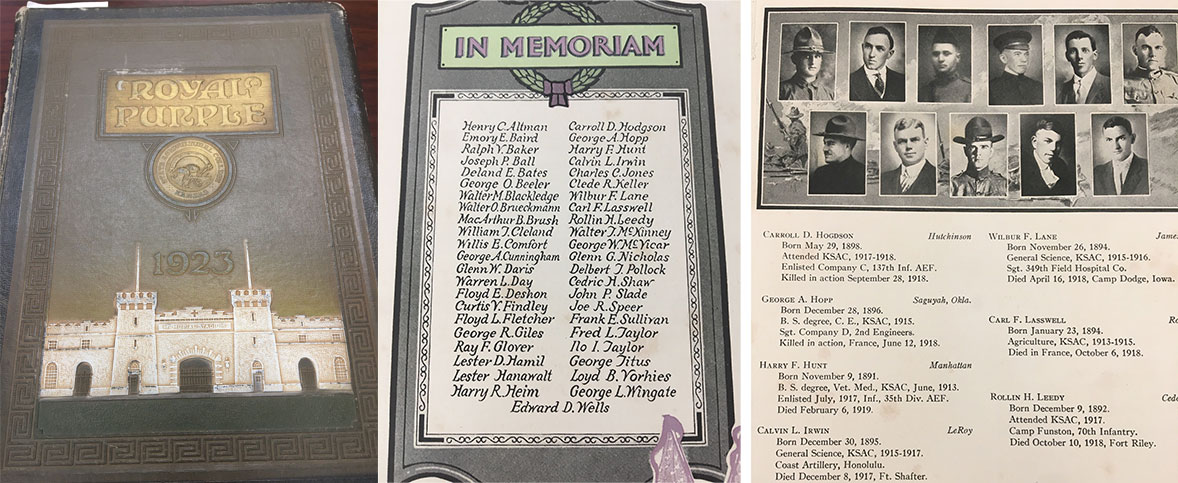CVM Graduate Biographies
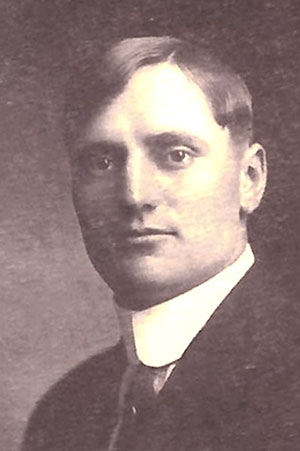 1913 - Harry Frank Hunt
1913 - Harry Frank Hunt
World War I beckons Lt. Harry Frank Hunt to veterinary service in France
Prologue: The 48 Fallen
A landmark on the K-State campus contains a piece of history that today is generally unknown or forgotten. At least it has been until a few years ago when a recent graduate took note.
“I came back to K-State for a lacrosse reunion,” says Jed Dunham, who earned a bachelor’s degree in advertising at K-State in 1996. “I was walking into Memorial Stadium on a beautiful crisp fall morning and walked past a plaque dedicated to the 48 students from this school who gave their lives during the first world war.”
Jed says he took many pictures on his visit to campus, and when he returned to his home in New Hampshire, he went through his pictures and “landed” on the picture of the plaque.
“I wanted to know who they were and what their lives meant,” Jed says. “And I thought with a very simple search on the Internet, all the answers would be solved.”
A plaque at Kansas State University recognizes the 48 K-State students who lost their lives during World War I. Of the 48, only eight had completed their degrees, and among those, only Harry Hunt had gone to veterinary school for a DVM degree. The inset on the left shows the full plaque and the inset on the right is the sign at the entrance to the field at the World War I Memorial Stadium.
But, the initial search results came up empty. Jed began to dig deeper until eventually he was able to unravel what he calls the “fascinating, beautiful, sad and horrific” accounts of each one of these lost K-Staters. The information Jed compiled assisted in the effort to formally dedicate World War I Memorial Stadium on April 21, 2017.
[Editor's note: Read more about the dedication ceremony and hear Jed Dunham's remarks as recorded by KMAN radio in Manhattan.]
“When I pursued the biographies of the ’48 Fallen,’” Jed recalls, “the history of the war was fascinating through individual experience.”
Among the 48 Fallen is a veterinary medicine graduate named Harry Hunt.
“Harry’s story represents an amazing part of history during World War I that started out with an ancient military relying on beasts of burden and evolved to divisions that were hauling weapons by tractors,” Jed says. “Harry was an eye witness to a transformative period of history. One hundred years later, when we are trying to make sense of that war, we lose sight of a dramatic evolution that started when the U.S. declared war on Germany on April 6, 1917. Fast forward to Nov. 11, 1918, and you realize these were two dramatically different experiences. We came out of the war differently.”
So how do we know so much about Harry and his experience during the war?
He wrote about it in his own words.
A Mysterious Journal
“I found a journal in my grandma's storage that sparked the project for my Mom to write a book,” says Kevin Brown of Tempe, Arizona. “She worked hard on that book. Most people today have no idea the roles played by horses and mules during both world wars. Even in World War II, over 80% of ordinance was moved by horses and mules. My great uncle’s job was very important for supporting the forces in World War I.”
Kevin’s mother, Faye Converse Brown, spoke to the Topeka Capital-Journal in 1998 upon publishing the book, “Letters Home: The true story of Lt. Harry Frank Hunt World War I.” While this book wasn’t a runaway bestseller, it provided a detailed account of one man’s experiences of serving his country during both a war and a global pandemic. It became a valuable resource for Jed Dunham toward completing the puzzle about one member of K-State’s 48 Fallen. It is also the primary source for this story.
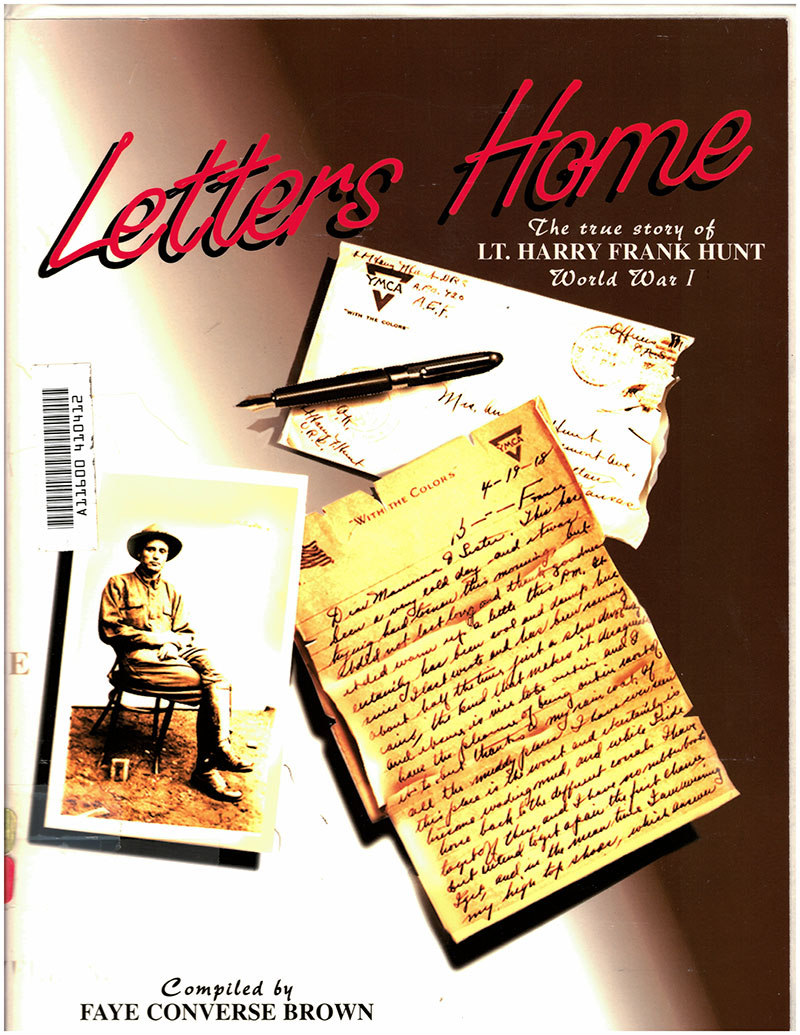
Faye passed away in 2013, so her comments to the press upon the book’s release give some insight on how Harry’s story came to be so well-preserved.
“I knew there were some letters that my mother had kept, so I asked my brother if I could use those and try to get them published,” Faye told the Capital-Journal. “I had the letters, since I was close to my grandmother and because I had stayed with her. When I got to reading the letters and knowing how the story ended, it was just so emotional it took me a couple of years to really settle down and get (it all) on my computer.”
Harry Hunt: Fredonia to Manhattan
Faye’s parents, Annie Sarah Brindle and Frank M. Hunt from were from Fredonia, Kansas. They had two children: Harry born Nov. 9, 1890, and Nellie [Faye’s mother] born Oct. 8, 1895.
Frank had been the superintendent of the town’s water plant, but he later moved his family to Goldfield, Colorado, to pursue gold mining. This decision proved to be ill-fated as Frank Hunt was killed in a mine accident when Harry was 10 and Nellie was 5.
Annie and the children returned to Wilson County, Kansas, to live on the John Brindle farm near Fredonia. Harry and Nellie attended Grand Valley School by a horse-drawn cart powered by a horse named Cripe.
Nellie, Harry and Cripe the horse prepare for a ride to school. Because Harry loved horses, he decided he wanted to be a veterinarian.
“Harry loved the farm animals, especially the horse, so it was not surprising to his mother when he announced his determination to become ‘an animal doctor,’” Faye says in the book.
To help him, Annie moved to Manhattan so Harry could enroll in the veterinary curriculum at Kansas State Agricultural College. She opened a boarding house at 1010 Bluemont Street.
While at K-State, Harry was on what was known as the “famous second football team.” We believe Harry is fourth from the left in the back row.
Harry Hunt was initiated into the Veterinary Medical Association at K-State in 1910 and he received his DVM in 1913. After graduation, Dr. Hunt worked for Southwestern Serum Company in Wichita. He met a young woman named Gesinda [also identified as Gesina], who nicknamed Gussie. Her last name was never mentioned in the letters and her whereabouts were later unknown to the family.
Dr. Harry Hunt on his graduation day in 1913.
Call to Duty
When the United States declared war on Germany in 1917, Dr. Hunt registered for the draft board. Not one to wait, he volunteered for service before he could be drafted. Dr. Hunt took the officer commission examination for the Veterinary Corps in Manhattan on June 30 and was commissioned as a second lieutenant on July 20. He received a telegram ordering him to active duty Sept. 18.
Dr. Harry Hunt worked for the Southwestern Serum Company in Wichita between his graduation and before joining the Army Veterinary Corps.
“Members of the Veterinary Corps were referred to as “casuals” as they were not permanently assigned to any particular division,” Faye explains in the book, which helps explain some of the context of the letters that he sent home.
“Harry gradually assumed the role of “head of the family” and protector of his mother and little sister,” Faye writes. “The three were enveloped in a loving closeness that would manifest itself in his letter written them years later.”
Harry joins his sister Nellie and mother Annie in front of the boarding house at 1010 Bluemont in Manhattan. The house has been replaced by an apartment building.
Harry, as it turns out, was a prolific letter writer. He loved to get letters from home and frequently referred to the different letters he had received, all while sharing details of his life in the Army Veterinary Corps. At this point in the book [and our story], the letters give the rest of the details. The quotes from these letters are unedited and faithful to the verbiage used by Harry. Ellipses indicate where text has been omitted for the purpose of brevity.
Harry’s Story
Nov. 3, 1917, from Camp Pike, Arkansas
“My dear Mamma & Sister,
“… I want you to send me a book out of the box, it is the largest one in there and is by Hickra & Myrick, Therapeutics and Pathology of Dom. Animals. It is a large book with half leather black binding and the cloth is green. There are two of them and I think it is Vol. 1. I want the one on infectious and contagious diseases. You can tell by looking through it because there are large articles on Tuberculosis, Rabies, Anthrax, Hemorrhagic Septicemia, Ruchipest, Hog Cholera.”
Dec. 13 – Letter to the commanding general at Camp Pike requesting a leave of absence.
“At the time I was ordered to active duty, I was residing at Wichita, Kansas engaged in the practice of veterinary medicine. Owing to the short time I had to report for duty after business affairs. I have had no opportunity to attend to said affairs since called. If granted the leave of absence requested I can finish my private business affairs at Wichita, Kansas and also visit my family at Manhattan, Kansas at the same time.”
Send Me Away With a Smile
March 3, 1918 from Camp Pike:
“I am leaving here Tuesday morning for Hoboken, N.J., just received the news today. There will be five Vets in this bunch I got with. Don’t know where we are going, but have kinda got an idea that I will soon be in sunny France, however I don’t know. Was somewhat surprised when I received the news but I am getting used to surprises nowadays. …
“Don’t let anything worry you, Mother, and remember the song that I like so well, ‘Send Me Away With A Smile.’ … And Mamma, remember that Gussie is my little girl, to be, so take good care of her if you ever see her, and that she likes you and Nellie fine.”
[Lt. Hunt arrived in New York City on March 6, and then reported to Hoboken, New Jersey, March 7. He received sailing orders on March 8.]
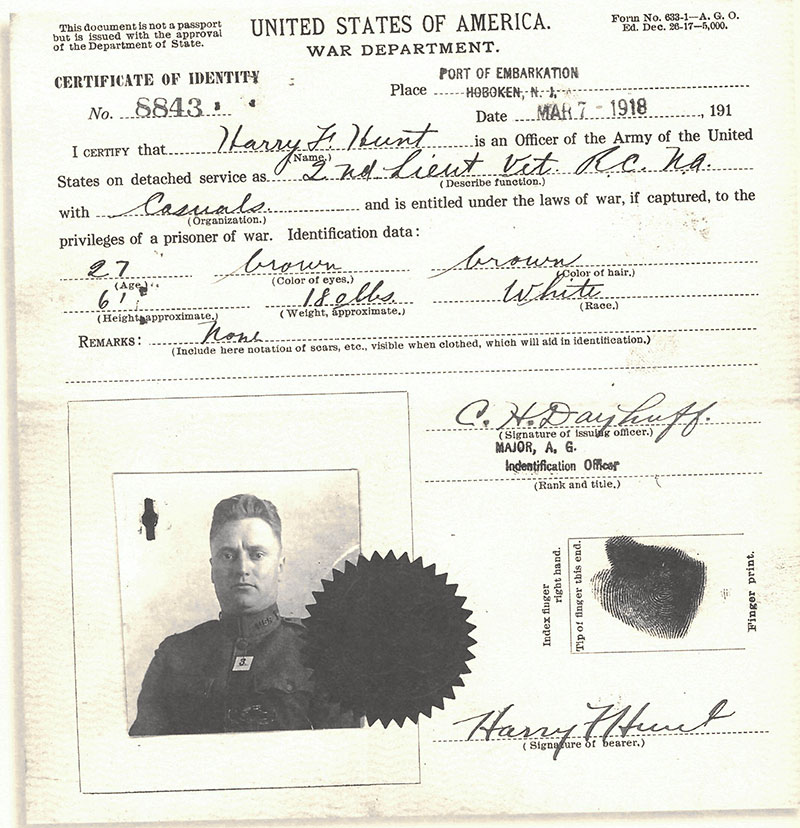
From Grand Hotel, Broadway and 31st St. [undated]
“I imagine you are kinda wondering where your boy is tonight, well Mamma, I am in Little Old New York and have been here for a couple of days but have been pretty busy all the time. … Mamma, this is sure some city is all I can say and to compare it with Kansas City would be like comparing K.C. with Manhattan and believe me now, it is some town.”
[Lt. Hunt sets sail for Europe on March 14]
First letter from “At Sea in the Atlantic” [undated]
“it is hard to get used to the continual rolling and pitching of the boat. It rolls from side to side so that one side will be from two to 15 feet higher than the other. … The vessel will pitch from end to end so that one end will be 25 feet higher than the other, but that does not bother very much.
“... There is quite a number of officers and men on this boat and most of them were sick the first few days out and it was funny to see them walk to the side of the boat and see how far out they could reach, but I have never felt better in my life than I have since coming on this boat. It was hard for me to get used to the roll of the vessel, especially at night, but I don’t mind that at all now. I sure thought I would get seasick, but so far no signs and I have been eating three squares a day …”
A copy of one of Harry's letters written on stationery from a hotel in New York City.
Somewhere in France
[Excerpt from the “Final Report of Gen. John J. Pershing” 1920]
“The shortage of animals was a serious problem throughout the war. In July, 1917, the French agreed to furnish our forces with 7,000 animals a month, and accordingly the War Department was requested to discontinue shipments. On August 24, however, the French advised us that it would be impossible to furnish the number of animals originally stated … Every effort was made to reduce animal requirements—by increased motorization of artillery and by requiring mounted officers and men to walk—but in spite of all these efforts, the situation as to animals grew steadily worse.”
[Passage from “Veterinary Military History of the United States,” Vol. II by Merillat and Campbell]
“… the proper place for the mobile veterinary section was in advance of the headquarters, among the trains and in action just behind the artillery where the casualties were to be expected and where it could cooperate with the corps and army in making evacuations …”
March 28
“Dear Mamma and Nellie,
“We came on shore yesterday and I am now staying at a hotel here in town. … I never felt better in my life and am having a very enjoyable time, considering everything.”
April 14
“A remount station is where large numbers of horses and mules are kept and we supply them to the Front, as it is called, as they need them up there. I have been kept pretty busy as you know there is lots of work around anything that is just starting and we have a good many sick ones on hand at present. While I am kept pretty busy I enjoy the work and it makes the time pass more rapidly.”
May 3
“I met a vet here today who just came over by the name of Ray from KSAC class of '16. I did not remember him, but he did me and I certainly enjoyed visiting with him over old times.”
May 5
“That vet's name from KSAC is spelled Reaugh instead of Ray as I said in my last letter.”
July 1
“I took about a 30-mile auto ride yesterday testing some horse for glanders down at some engineering camp and part of the time we were in a forest reserve.”
Sept. 6
“The horses I have here are commencing to look much better and I hope soon to have them well and back in action. Will send the best away in a few days. I have been having some very good horseback rides lately and I certainly enjoy riding.”
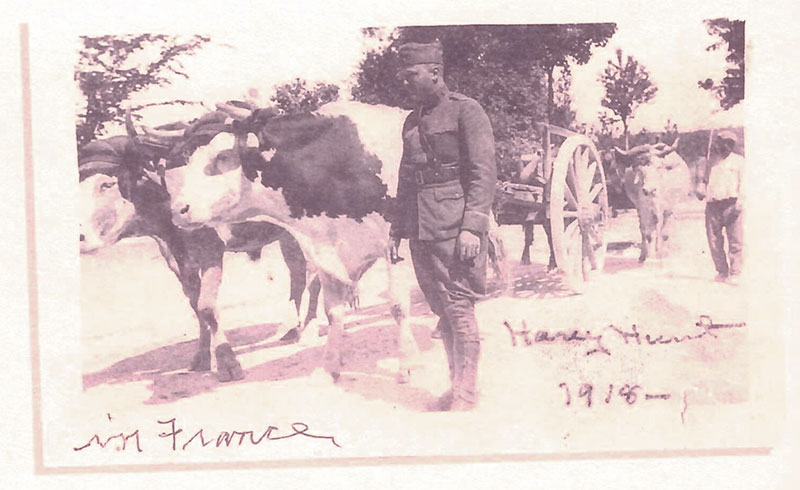
Lt. Harry Hunt tends to cattle used for hauling munitions in France during World War I.
Sept. 27
“I think I am being assigned to the 35th Div. which is the Kansas and Missouri National Guard so guess I will meet quite a number of my old friends.
“I saw Dr. Newton’s brother the other day and was with him about two days. He is with the 35th Div. so may see him again soon. I am now very close to the Front and will go closer tomorrow. Passed over several of the old battlefields today and saw many of the ruins from some of the battles.”
Nov. 3 (received by Annie on Nov. 30)
“From what we read in the papers, I guess you folks are enjoying (?) a siege of this Spanish influenza, but you must be careful and not catch it. This is no time for people to get sick.”
The War to End All Wars
Nov. 17
“Sunday night and it is a very peaceful, quiet evening and a good deal more quiet than when I last wrote to you. … I imagine that the 11th hour of the 11th day of the 11th month of 1918 will never be forgotten because at that time the largest war in history ended and it was the first time in over four years that shells ceased being thrown across the battle line.
“And now the great question, how soon will we get home, all kinds of rumors are going about. Some think we will be in American by the first of the year 1919 and I only hope they are correct.
“I heard the other day that the Spanish influenza has been causing a good many deaths in America and for some cause or other it has worried me considerable. I trust that everything is allright.”
Jan. 5, 1919
“I don’t think I will be with this regiment much longer as it is to be motorized, and some of the motors are here now. Wish they would make me a casual and send me home, but I am afraid that won’t happen as we are getting too many horses over here.
“And so, Mamma, you think that this will be the last war, well you know the old saying that great minds don't always run in the same channel. I think there will be wars just as long as this old world is run or tried to be run by human beings, because there is too much animal nature in the people of the world not to fight, and every war will get worse in proportion to the education and knowledge of the people, as modern means of slaughter will always lead.”
Waiting to Return Home
Jan. 11, from Sampaigny France
“I am now with the 69th Infantry Brigade and we are located now about twelve kilo. north of Commercy and about the same distance south of St. Mihiel. … We’re quartered here in French houses or parts of houses and have very good quarters but it is hard to get enough wood to keep warm by. … I still have hopes of being with you in the spring.”
Jan. 26
“Just finished mallium testing the entire brigade this week and got one reactor and that means I must test this regiment every seven days for the next month so I guess I will be kept pretty busy.”
Feb. 1
“Saturday night and ‘tis a very cold night and this week has been very cold with a little snow mixed in. … the cold is very disagreeable here because we have no warm place to go or to stay. The rooms are very airy due to so many shell holes in the house … I am sure glad it is not as cold here as we hear it is in the U.S.A., and especially Kansas. From all reports I guess you are having one of the coldest winters in history. I am hoping your coal is holding out and that you are keeping warm. Take it from me I am not very warm.”
Feb. 5
[Letter from Lt. Hunt to Commander-in-Chief, American E.F. (thru military channels); Subject: Resignation]
“Before entering the United States Army, I was engaged in the manufacture of Anti hog cholera serum for the prevention of hog cholera and was financially interested in the Southwestern Serum Company, Wichita, Kansas. I intend to resume my duties with this Company as soon as I am discharged from the Service. … In recent statistics given by the Bureau of Animal Industry, the annual loss of hogs due to this disease was fifty million dollars, and for this reason believe that my services are of more value for the conservation of meat in the United States than they would be in this country.”
Tragedy Strikes
March 3
[Letter written by Annie but not signed.]
“One of our letters to you, dated Nov. 2nd, came back Thursday. It had a blue pencil marked base hospital No. 8, so there must be other Harry Hunts over there. … There was a Cpt. Hicky in France from Manhattan and not one bit of mail did he get, or none from his wife, while he was in France. He is home now. So many are coming home, and we hope to see you soon. …
“Am sorry you are so poorly housed, and hope you will be more comfortable when this reaches you. …
“We have a message from Washington saying Harry F. Hunt had died Feb. 6th from gas. We doubted it, because we wondered what you would be doing with gas now. We wrote Washington, and sent a cable to France to the Major of your company, and as yet have had no reply, but we are very hopeful.”
March 3
[Letter from Maj. C.B. Robbins, Headquarters, Sixty-Ninth Infantry Brigade, A.E.F. France]
“Mrs. Annie S. Hunt,
“Dear Madam: Your cablegram asking for verification of the death of Lieut. Harry F. Hunt was received this morning at these headquarters and I want to send a cablegram to the Red Cross to be sent to you, as follows:
“’Lieutenant Harry F. Hunt died February 5th, 1919, accidental charcoal gas poisoning.’
“… Lieutenant Hunt had been having a touch of Influenza or a bad cold and was staying in his quarters. The stove had been filled up with charcoal and Lieut. Hunt apparently laid down upon his bunk and gone to sleep. The pipe was partly choked and the gas given out by the charcoal was sufficient to cause his death while asleep. His body was found only a few hours after death occurred and there were no signs of a struggle and apparently his death had been very peaceful.
“I saw him only the day before his death … he had done splendid work in caring for the animal transportation of [his] regiment. We all felt a sense of personal loss at his death.”
Postscript: Back Home
Harry’s body did not get returned to the U.S. until more than two years later. Mrs. Hunt chose to wait for all bodies to be returned before inquiring about her son’s body. She wrote the War Department in Washington, D.C., and asked that his body be sent to Fredonia. A funeral was held on the courthouse lawn in Fredonia on Sunday, July 3, 1921, and Lt. Hunt was laid to rest in the Fredonia City Cemetery.
Lt. Harry F. Hunt receives a military funeral at the Fredonia (Kansas) City Cemetery on July 3, 1921 — more than two years after he died in France.
After Harry’s death, Annie continued living at the boarding house at 1010 Bluemont Street. The house has since been replaced by an apartment complex. His sister Nellie married Merle Converse and lived on Pine Crest Farm 9 miles south of Eskridge, Kansas, where they had six daughters and three sons.
From Nellie’s family, three grandchildren became veterinarians and earned their DVM degrees at K-State: Dr. Ginny Warren, DVM class of 1976; Dr. Charles Van Petten, DVM class of 1978; and Dr. Jeff Van Petten, DVM class of 1983. The three cite different influences for becoming veterinarians, but they weren't specifically influenced by Harry in developing their interests in veterinary medicine.
Dr. Warren says her grandmother, Nellie, gave her some of Harry’s medical instruments when she was young, and that Nellie spoke about Harry quite often. Nellie gave Dr. Warren lots of encouragement while she attended veterinary college, as well as wisdom and life lessons. Harry had a love of horses and so did Dr. Warren’s mother. She was raised on a ranch and participated in rodeo. Dr. Warren says both her mother, Ramona, and grandmother, Nelli,e were her “rocks” — people she could count on.
Dr. Jeff Van Petten says he remembers learning about Harry Hunt later in life.
“I did not know about Harry Hunt other than he had died in the first world war and until a few years ago that he was a DVM,” Dr. Jeff Van Petten says. “My decision to be a veterinarian came at an early age. I would have been about a third grader and we had a beagle get ran over. A doctor on the west side of Topeka repaired her fractured pelvis with a Kirschner apparatus, and after that, I wanted to be a vet. Then there were several veterinarians I spent time with who also influenced me: Dr. William Boley [DVM 1951] from Harveyville and Dr. Pete Zander [DVM 1969] in Auburn. It was a special day to me when I learned of Lt. Harry Hunt’s DVM and sacrifice for our country.”
Annie passed away at age 83 in 1948. Nellie died in 1981 at age 85. Faye had attended K-State and earned a journalism and home economics degree in 1950. She worked as a part-time reporter for the Marysville Advocate, and later for the Arizona Senior World, after relocating from Marysville to Tucson, Arizona. She was living in Arizona when she wrote the book. Faye is survived by her two sons: Kevin and Steven.
In the 1923 edition of the Royal Purple, the K-State yearbook, 45 of the 48 Fallen were honored in conjunction with the original dedication of the Memorial Stadium. Apparently, three of the fallen K-Staters were not identified until a later date. The pages of the Royal Purple listed the pictures, hometowns, class or attendance years and date of death for each of these brave heroes.
Learn more about Harry's life and read more of his letters in the book, "Letters Home," available in select libraries and through various online book retailers.
Written by Joe Montgomery, April 2021
